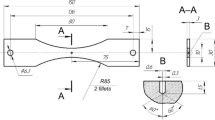Abstract
A procedure is presented for predicting the fatigue behavior at elevated temperature by extending the unified theory of fatigue damage previously proposed for room temperature. The method predicts the experimental results of high-temperature push-pull tests under isothermal conditions, using the total strain range. The analysis is based on parameters obtained from short-term tensile tests in which the temperature and the strain rate are the same as for the fatigue test.
The procedure is applied for fatigue of a stainless steel at 650°C under cyclic axial strain. It has also been applied to published data for three austenitic stainless steels. In general, the present procedure gives estimates closer to experimental results than those obtained from other known methods.
Similar content being viewed by others
Abbreviations
- A, C, K, c, k, p :
-
material constants
- E :
-
elastic modulus, (N/m2)
- f :
-
frequency of cycling
- m :
-
strain-hardening exponent in short-term tensile test
- N :
-
number of cycles at failure
- T :
-
test temperature (°C)
- T m :
-
melting temperature (°C)
- t r :
-
time for rupture in a creep test
- β:
-
slope of straight line in δɛ p —N diagram
- v e :
-
Poisson's ratio for elastic strain
- v p :
-
Poisson's ratio for plastic strain
- σ u :
-
ultimate tensile strength, (N/m2)
- σ f :
-
true stress at fracture, (N/m2)
- σ r :
-
applied stress in a creep test
- \(\dot \in \) :
-
axial-strain rate (s−1)
- ɛ f :
-
true strain at fracture
References
Dubuc, J., Bui-Quoc, T., Bazergui, A. and Biron, A., “Unified Theory of Cumulative Damage in Metal Fatigue,” Welding Res. Coun., Bulletin No. 162 (June 1971).
Littler, D. J. (Ed.).Thermal Stresses and Thermal Fatigue, Butterworths, London (1971).
Fatigue at Elevated Temperatures, American Society for Testing and Materials, STP 520 (1973).
”Creep and Fatigue in Elevated Temperature Applications,” Inst. of Mech. Eng., Conf. Publ. No. 13 (1973–74).
Saheb, R. E., “A Study of the Interaction Between Creep and Fatigue for an Austenitic Stainless Steel at High Temperature,”PhD thesis, Ecole Polytechnique, Montreal, Canada (1973).
Bui-Quoc, T. and Biron, A., “Low Cycle Fatigue under Controlled Axial Strain with Axial and Diametral Strain Measurements,” in preparation.
Saheb, E. and Bui-Quoc, T., “Role of Strain-Hardening Exponent in the Life Prediction in High-Temperature Low-Cycle Fatigue,” Int. Conf. on Creep and Fatigue in Elevated Temperature Applications, Philadelphia, and Sheffield, UK (1973–74).
Wells, C. H., “Elevated Temperature Testing Methods,” ASTM STP 465, 87–99 (1969).
Manson, S. S. and Halford, G., “A Method of Estimating High-Temperature Low-Cycle Fatigue Behavior of Materials,” Thermal and High-Strain Fatigue, The Metals and Metallurgy Trust, London, 154–170 (1967).
Berling J. T. andConway, J. B., “A New Approach to the Prediction of Low-Cycle Fatigue Data,”Metallurgical Trans. 1, 805–809 (1970).
Leven, M. M., “The Interaction of Creep and Fatigue for a Rotor Steel,”Experimental Mechanics,13 (9),353–372 (Sept.1973).
Coffin, L. F., “An Investigation of the Cyclic Strain and Fatigue Behavior of a Low-Cycle Manganese Steel at Elevated Temperature,” Thermal and High-Strain Fatigue, The Metals and Metallurgy Trust, London, 171–197 (1967).
Berling, J. T. andSlot, T. “Effect of Temeperature and Strain-Rate on Low-Cycle Fatigue Resistance of AISI 304, 316, 348 Stainless Steels, ASTM STP 459, 3–30 (1969).
Bui-Quoc, T., Dubuc, J., Bazergui, A. andBiron, A., “Cumulative Fatigue Damage under Strain-Controlled Conditions,”J. of Materials,6,718–737 (1971).
Miller, K. J. “The Effect of Strain Rate on Low-Endurance Torsional Fatigue in an Alloy Steel,” Thermal and High Strain Fatigue, The Metals and Metallurgy Trust, London, 225–238 (1967).
Bui-Quoc, T. andBiron, A., “Extension of Unified Theory of Fatigue Damage for High Temperature Life Prediction, Rapport Technique EP74-R-16”Ecole Polytechnique, Montreal, Canada (1974).
Author information
Authors and Affiliations
Rights and permissions
About this article
Cite this article
Bui-Quoc, T. High-temperature fatigue-life estimation: Extension of a unified theory. Experimental Mechanics 15, 219–225 (1975). https://doi.org/10.1007/BF02319426
Received:
Revised:
Issue Date:
DOI: https://doi.org/10.1007/BF02319426




